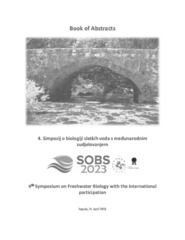Приказ основних података о документу
Benthic macroinvertebrates of the upper stretch of the Neretva River
| dc.contributor | Mičetić Stanković, Vlatka | |
| dc.contributor | Ivković, Marija | |
| dc.contributor | Matoničkin Kepčija, Renata | |
| dc.contributor | Sertić Perić, Mirela | |
| dc.contributor | Miliša, Marko | |
| dc.contributor | Vilenica, Marina | |
| dc.creator | Tubić, Bojana | |
| dc.creator | Zorić, Katarina | |
| dc.creator | Atanacković, Ana | |
| dc.creator | Ilić, Marija | |
| dc.creator | Čanak Atlagić, Jelena | |
| dc.creator | Popović, Nataša | |
| dc.creator | Marinković, Nikola | |
| dc.creator | Tomović, Jelena | |
| dc.creator | Raković, Maja | |
| dc.creator | Anđus, Stefan | |
| dc.creator | Paunović, Momir | |
| dc.date.accessioned | 2023-05-26T10:02:44Z | |
| dc.date.available | 2023-05-26T10:02:44Z | |
| dc.date.issued | 2023 | |
| dc.identifier.issn | 2459-8402 | |
| dc.identifier.uri | http://radar.ibiss.bg.ac.rs/handle/123456789/5699 | |
| dc.description.abstract | The aim of this study was to identify taxa richness of benthic macroinvertebrates region of the Neretva River, which is under the potential impact of human activities. The "Neretva Science Week" study area is located in eastern Bosnia and Herzegovina and it covers the upper region of the Neretva River, between its confluence with the Krupa River and the city of Konjic. In the summer 2022, aquatic macroinvertebrates were collected from a total of nine sites: seven sites on the Neretva River and two on its tributary Krupa River. Kick and Sweep hand net sampling was performed following the EN 27828:1994 standard. In total, 101 taxa belonging to 13 taxonomic groups were recorded. Based on our results, Diptera and Ephemeroptera were most taxa rich (17 and 18 taxa, respectively) and most abundant taxa (with 27.19% and 34.79% of collected individuals, respectively), followed by Trichoptera (24 taxa; 12.98% of collected individuals) and Plecoptera (6 taxa, 15.95% of collected individuals) At the lower taxonomic level, the most abundant taxa were mayfly Ecdyonurus alpinus Hefti, Tomka & Zurwerra, 1987 and Simuliidae (Diptera) larvae. Overall, our results indicate high benthic macroinvertebrate taxa richness, and domination of insect orders that typically occur in mountain rivers, such as the upper reaches of the Neretva River. In order to preserve the pristine character of the river, as well as its biota, it is essential to maintain the near-natural state. | sr |
| dc.language.iso | en | sr |
| dc.publisher | Zagreb: Croatian Association of Freshwater Ecologists | sr |
| dc.relation | info:eu-repo/grantAgreement/MESTD/inst-2020/200007/RS// | sr |
| dc.rights | openAccess | sr |
| dc.source | Book of Abstracts: 4th Symposium on Freshwater Biology with the international participation; 2023 Apr 21; Zagreb, Croatia | sr |
| dc.subject | aquatic macroinvertebrates | sr |
| dc.subject | diversity | sr |
| dc.subject | Neretva River | sr |
| dc.title | Benthic macroinvertebrates of the upper stretch of the Neretva River | sr |
| dc.type | conferenceObject | sr |
| dc.rights.license | ARR | sr |
| dc.rights.holder | © 2023 by the Croatian Association of Freshwater Ecologists | sr |
| dc.description.other | Mičetić Stanković V, Ivković M, Matoničkin Kepčija R, Sertić Perić M, Miliša M, Vilenica M, editors. Book of Abstracts: 4th Symposium on Freshwater Biology with the international participation; 2023 Apr 21; Zagreb, Croatia. Zagreb: Croatian Association of Freshwater Ecologists; 2023. p. 63. | sr |
| dc.citation.spage | 63 | |
| dc.type.version | publishedVersion | sr |
| dc.identifier.fulltext | https://radar.ibiss.bg.ac.rs/bitstream/id/12944/bitstream_12944.pdf | |
| dc.citation.rank | M34 | |
| dc.identifier.rcub | https://hdl.handle.net/21.15107/rcub_ibiss_5699 |

